
* In the 1950s, the Piper company -- having made a success of its famous line of "Cub" light civil aircraft -- decided to get into the light twin business, introducing the "Apache" twin, which proved successful, and led to "Aztec" derivatives. In the 1960s, Piper introduced a larger twin, the "Navajo" executive aircraft, which also proved successful, leading to the "Cheyenne" derivative. This document provides a history and description of the Apache, Navajo, and their descendants -- as well as of the larger one-shot "Pocono". A list of illustration credits is provided at the end.
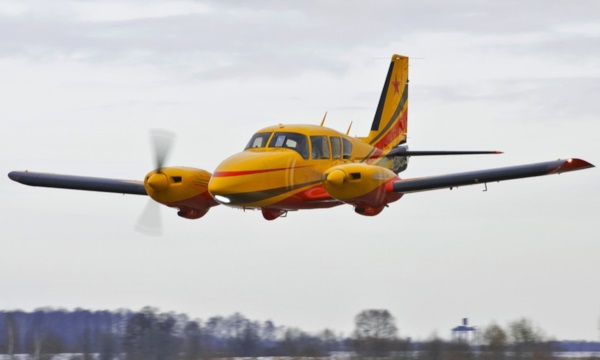
* In 1949, the Piper aircraft company bought up the Stinson Division of the Consolidated-Vultee Aircraft Corporation. The acquisition included a twin-piston light civil aircraft that had been under consideration before the purchase, with Piper management believing the "Twin Stinson" was a good basis for Piper's first twin. The prototype aircraft performed its initial flight on 2 March 1954.
The original Twin Stinson prototype was a low-wing aircraft, with twin piston engines and retractable tricycle landing gear. It featured a steel-tube airframe with fabric skinning, as well as dual tailfins and Lycoming O-290-D flat-four air-cooled engines with 95 kW (125 HP) each. It left much to be desired, the biggest problem being that it was underpowered. Two more prototypes were built with more powerful engines and other changes, leading to the commercial introduction of the "PA-23 Apache" in 1954.
As the production PA-23 emerged, it visibly differed from the Twin Stinson in having a conventional single tailfin -- as opposed to the twin tailfins of the Twin Stinson -- and aluminum alloy sheathing over the steel-tube airframe. It also had Lycoming O-320-A flat-four engines, with 110 kW (150 HP) each. They drove two-bladed variable-pitch propellers. There was a 136-liter (36 US gallon) and, as an option, a 68-liter (18 US gallon) fuel tank in each wing, for a total of 408 liters (108 US gallons). A few percent of that wasn't usable, the same being true for other aircraft described in this document. The baseline PA-23 would later be described as the "PA-23-150", for its engine power, when other variants came out.
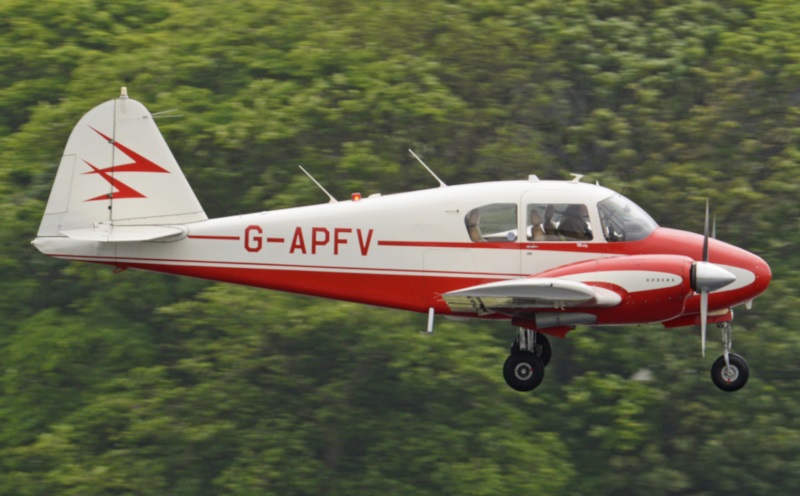
The wings were rectangular with rounded tips, plus a small fillet between each engine and the fuselage, and a similar fillet outboard of each engine. The tailplanes were tapered, while the tailfin was a rounded-off triangle. Flight control surfaces were conventional, with ailerons, one-piece flaps, elevators, rudder, plus trim tabs -- all being manually actuated, except for hydraulically-actuated flaps.
All landing gear assemblies had single wheels, the nose gear retracting backwards, the main gear retracting forward into the rear of the engine nacelles. The main wheels were half-exposed on retraction, giving some protection in a wheels-up landing. The landing gear was hydraulically actuated. A few Apaches were fitted with floats.
Cabin access was via a forward-hinged door on the right, with a handhold and fixed step to help get up on and climb down from the wing. There were two bucket seats in front, plus two seats in rear; they were either bucket seats or a bench seat, it being unclear as to which was normal. There was a baggage area behind the rear seats, with an access door on the right. Dual controls were standard. The 1954 production standard was the "Apache A", being followed by the "Apache B" for 1955, the "Apache C" for 1956, and the "Apache D" for 1957. They were all very similar, with only minor tweaks for each production year.
* However, the 1958 production "Apache E" design featured O-320-B engines with 120 kW (160 HP) each, being appropriately named the "Apache 160" or "PA-23-160" to distinguish it from earlier Apaches. The Apache E was followed in turn by the "Apache G", with a redesigned and longer cabin, plus an extra window; and then the "Apache H", with improved O-320-B2B engines and minor tweaks.
In 1959, Piper introduced a PA-23 variant powered by Lycoming O-540 flat-six engines, providing 185 kW (250 HP) each. It also had a swept tailfin, and five seats, an extra seat being crammed into a third row. It was designated the "PA-23-250 Aztec A" -- though apparently it was also, at least informally, referred to as the "PA-27 Aztec". Fuel supply was increased to two 136-liter (36 US gallon) fuel tanks in each wing, for a total fuel supply of 546 liters (144 US gallons). The more powerful engines were very welcome, the PA-23-150 and PA-23-160 having problems in maintaining altitude on a single engine. Even with the new engines, the Aztec had trouble maintaining altitude on a single engine on a hot day with a full load.
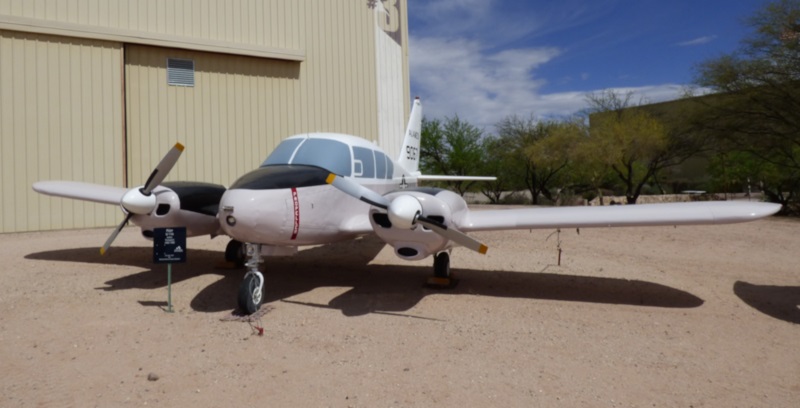
The US Navy obtained 20 Aztecs, designating them "UO-1", which was changed to "U-11A" when the Pentagon standardized designations across the military services in 1962. The "Aztec B" was introduced in 1961, this variant featuring a longer nose for baggage storage, six seats, and various tweaks. The sixth seat was crammed in along with the fifth in the third row of seats; apparently the third-row seats were only satisfactory for small children, and the third row was often removed in practice.
In 1962, Piper introduced the "PA-23-235 Apache", with O-540 engines providing 175 kW (235 HP) and the swept tailfin of the Aztec. This was the final model of the Apache, with production ended in 1965, Piper then focusing on the Aztec. Later Aztec models included:
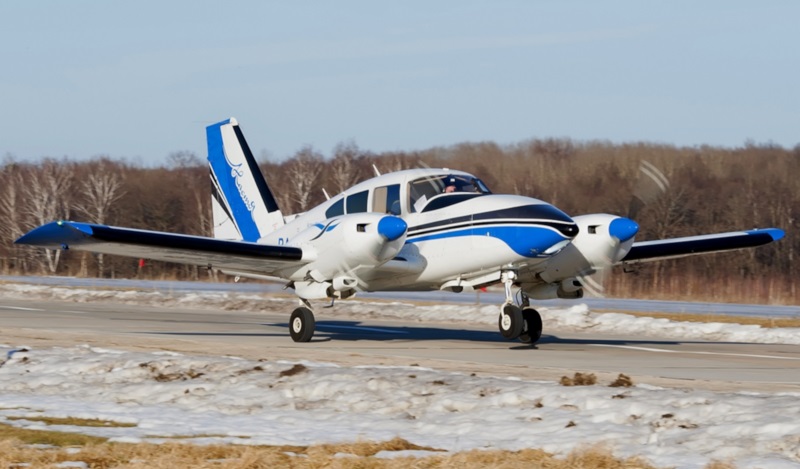
Piper flew a single "PA-41P Pressurized Aztec" in 1974, but the scheme didn't work out, the pressurization adding too much to cost, and cramping the roomy cabin that was one of the Apache / Aztec's best features.
___________________________________________________________________
PIPER PA-23-235 AZTEC F:
___________________________________________________________________
wingspan:
11.34 meters (37 feet 3 inches)
wing area:
19.28 sq_meters (207.6 sq_feet)
length:
9.52 meters (31 feet 3 inches)
height:
3.15 meters (10 feet 4 inches)
empty weight:
1,440 kilograms (3,180 pounds)
MTO weight:
2,360 kilograms (5,200 pounds)
max speed:
345 KPH (215 MPH / 185 KT)
cruise speed:
275 KPH (170 MPH / 150 KT)
take-off distance (to 15 meters / 50 feet):
515 meters (1,695 feet)
landing distance (from 15 meters / 50 feet):
490 meters (1,605 feet)
service ceiling:
5,780 meters (18,950 feet)
range:
2,445 kilometers (1,520 MI / 1,320 NMI)
___________________________________________________________________
In its prime, Piper offered an elaborate "Chinese menu" of options for the Aztec, and possibly later models of the Apache. Production of the Aztec ended in 1982, totals for the family being:
Although the Apache / Aztec's performance was unspectacular, it was honored by pilots, one describing it as a "big, forgiving twin with bulbous proportions, and the comfort of a living room chair." It had good short-field capability, was responsive on the controls, and was very stable -- a pilot could take both hands off the controls for a moment, without difficulty -- though it did tend to pitch up if the flaps were lowered too hastily. It was often flown in its later years as a multi-engine trainer because of its docility.
Along with the US Navy U-11As, the PA-23 was used in the liaison / utility role by the armed services of a number of countries, including Argentina, Bolivia, Brazil, Cameroon, Colombia, Costa Rica, El Salvador, Honduras, Madagascar, Mexico, Nicaragua, Paraguay, Spain, Uganda, Uruguay, and Venezuela. Plenty of PA-23s remain in service, with a number of firms offering engine, aerodynamic, cockpit, and avionics updates.
BACK_TO_TOP* In 1962, the Piper company began work on a six / eight-seat twin-engined corporate and commuter transport, under the name of "Inca". The initial prototype of the "PA-31" performed its first flight on 30 September 1964. Development proved troublesome, with the "Navajo", as it had been formally named, not certified until late 1966, and deliveries in the next year.
The PA-31 was of typical Piper twin configuration, being an all-metal aircraft with low-mounted wings, conventional tail assembly, and tricycle landing gear -- all gear with single wheels, the main gear retracting towards the fuselage, the nose gear retracting backward. It was powered by two turbocharged, fuel-injected Lycoming TIO-540-A air-cooled flat-six engines with 230 kW (310 HP) each, driving two-bladed variable-pitch propellers. It was eventually designated "PA-31-310" to distinguish it from later variants. Fuel capacity was 720 liters (192 US gallons) in four rubber wing tanks.
Dual controls were standard. Flight control surfaces were of conventional arrangement, with ailerons, flaps, rudder, elevators, and trim tabs. There were three passenger windows on the left side, with the rear window in a split "airstair" door, the lower half of which featured steps. There was an additional "guitar pick" window on the rear of the right side, with the foremost window also being an emergency exit. There was some confusing variation in the windows fitted; originally, it seems there were only two passenger windows on each side; and a guitar pick window was sometimes also fitted on the left. Baggage was stored in the rear and in the nose, with a baggage door on the left side of the nose.
De-icing boots and windscreen heating were optional, as was all-weather flight instrumentation and weather radar, with different levels of avionics kit available as sales packages. Along with the "Standard" configuration, it was also available in a "Commuter" configuration -- six passenger seats as normal, with airliner fixtures such as a NO SMOKING / FASTEN SEAT BELT sign and a cockpit curtain -- and the "Executive" configuration, with four passenger seats standard, in a club configuration, plus folding tables, refreshment center, and toilet. There were variations on executive fit as per customer order.
The "PA-31-300" variant was introduced in 1967, this machine being cost-reduced, with non-turbocharged Lycoming IO-540-M1A5 engines providing 225 kW (300 HP) each; it was the only PA-31 to have non-turbocharged engines. The original PA-31 continued to be produced, being redesignated "PA-31-310". The low-cost PA-31-300 was a failure, being discontinued after two years of production, with only 14 sold.
The "PA-31P Pressurized Navajo" was introduced in late 1969. It was powered by Lycoming TIGO-541-E turbocharged, fuel-injected, and geared flat-six engines with 315 kW (425 HP) each, being more specifically known as the "PA-31P-315". It featured a longer nose, fewer and smaller windows, a fuel tank in each engine nacelle, and a one-piece airstair door, instead of the split door of the unpressurized model. An optional ninth seat was introduced into the family at this time. The Pressurized Navajo had substantially increased max take-off weight.
A "B" version of the baseline PA-31-310 was introduced in 1971, featuring air conditioning, storage lockers in the rear of extended engine nacelles, an optional auxiliary cargo door mated to the rear of the passenger door, an optional crew cabin door, and optional three-bladed props.
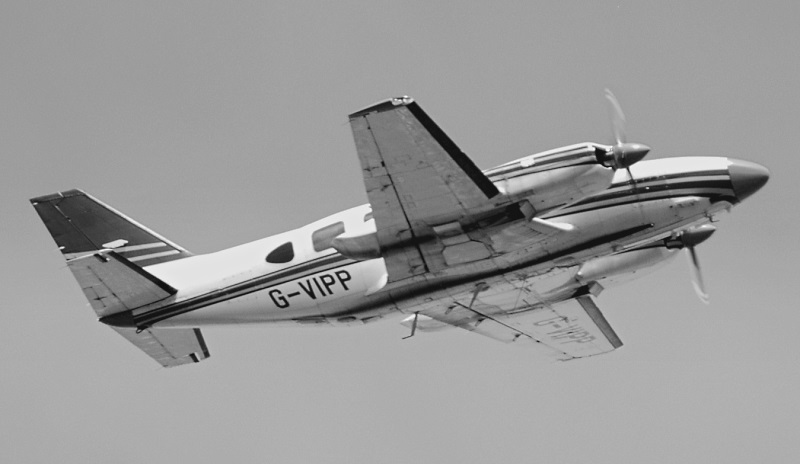
In 1972, Piper unveiled the "PA-31-350 Navajo Chieftain", or just "Chieftain" for short, which was a PA-31-310 stretched by 61 centimeters (2 feet), adding two more seats plus another window on each side, and with more powerful TIO-540-J2BD engines, providing 260 kW (350 HP). The engines were "handed", spinning the prop in opposite directions to negate torque -- the left-handed version being the "LTIO-540-J2BD". Other than that, it was broadly similar to the PA-31-310 Navajo B, with the same fuel capacity, the same baggage storage system, and the auxiliary cargo door made standard. Introduction to service was delayed into 1973 by a flood at the Piper Lock Haven CT factory, due to a hurricane.
___________________________________________________________________
PIPER PA-31-350 NAVAJO CHIEFTAIN:
___________________________________________________________________
wingspan:
12.4 meters (40 feet 8 inches)
wing area:
21.27 sq_meters (229 sq_feet)
length:
10.55 meters (34 feet 8 inches)
height:
3.96 meters (13 feet)
empty weight:
1,915 kilograms (4,220 pounds)
MTO weight:
3,175 kilograms (7,000 pounds)
max speed:
430 KPH (265 MPH / 230 KT)
service ceiling:
7,315 meters (24,000 feet)
range:
2,390 kilometers (1,485 MI / 1,290 NMI)
___________________________________________________________________
Following the Chieftain, in 1975 Piper began deliveries of an updated version of Navajo B, the "PA-31-325 Navajo C/R", which also featured "handed" TIO-540 engines, but with power ratings of 240 kW (350 HP) each. The baseline PA-31-310 still remained in production, being updated to a "Navajo C" configuration, with updated TIO-540-A2C engines, three-bladed props as standard, and other tweaks.
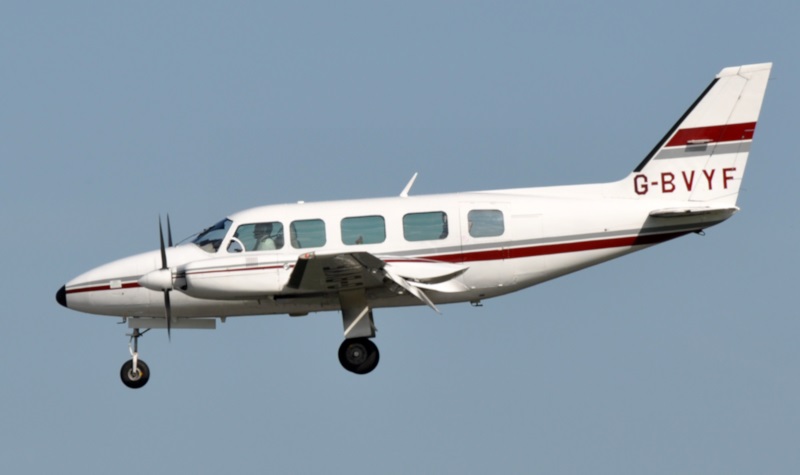
In 1981, Piper set up the "T1000 Airliner Division" at its Lakeland FL factory, with two products in its line:
The very last production PA-31 was the "PA-31P-350 Mojave", which was something of the reverse of the T1040: it had a Cheyenne fuselage, but Chieftain-derived wings and tail. The wings were reinforced and stretched in span by 1.2 meters (4 feet), while the fuel supply was increased to 902 liters (238 US gallons). The Mojave was only built in 1983 and 1984. During the 1980s, the company also did produce two experimental "PA-31-353" machines, about which nobody seems to know anything.
There was license production of the PA-31, using parts kits supplied by Piper:
Total production quantities, not counting the two mysterious PA-31-353s, were:
Presumably foreign assembly is included in these figures. Navajos have been flown in the utility role by a number of military forces, including those of Chile, Dominican Republic, Finland, France, Honduras, Kenya, Spain, and the UK. The French Aeronavale -- naval air arm -- was the biggest military user, obtaining 12. Many remain in service, variously being given engine and avionics updates, updated interiors, or other features such as winglets.
BACK_TO_TOP* It would have seemed like the Navajo could benefit from turboprop propulsion from the outset, but it wasn't until later in the 1960s that turboprops began to catch on for small civil aircraft. Piper then developed a turboprop member of the family, with the first prototype of the "PA-31T Cheyenne" performing its initial flight on 29 August 1969. It was derived from the PA-31P Pressurized Navajo, but featured twin Pratt & Whitney Canada (PWC) PT6A-28 turboprop engines with 460 kW (620 SHP) each, driving three-bladed Hartzell variable-pitch propellers. It had three fuel cells in each wing, plus wingtip tanks with a capacity of 114 liters (30 US gallons) each, total fuel supply being 1,476 liters (390 US gallons),
To be certified, the PA-31T had to include a stability augmentation system (SAS), since it otherwise tended to be unstable in parts of its flight regime. It normally had two cockpit seats and four cabin seats, though two more cabin seats were an option. Air conditioning was standard. One was kitted up with a radar pod to demonstrate the type's utility for the coastal patrol and other special missions, but it is unclear if any special-mission PA-31Ts were actually sold.
In 1978, Piper introduced the "PA-31T-1", which was much the same as the original PA-31T, but had less powerful PWC PT6A-11 turboprop engines with 375 kW (500 SHP) each. It didn't require a SAS. The wingtip fuel tanks were optional, but customers usually took that option. Ultimately, the original PA-31T became -- somewhat counterintuitively -- the "Cheyenne II", while the PA-31T-1 became the "Cheyenne I".
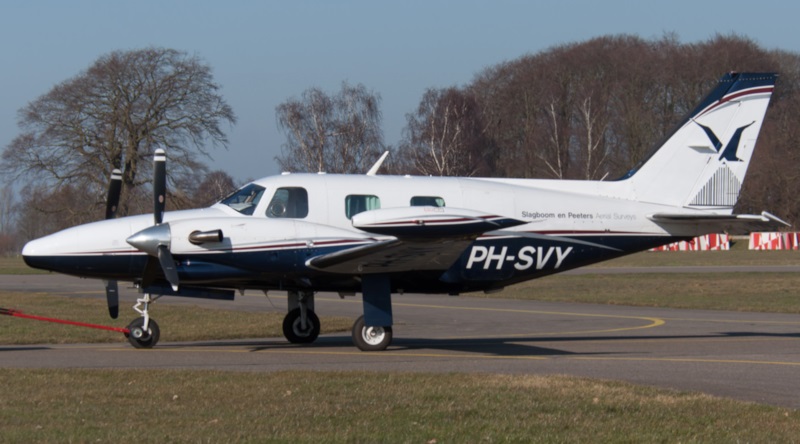
The Cheyenne II was enhanced in 1981 to the "PA-31T-2 Cheyenne IIXL", which had a 61-centimeter (2-foot) fuselage stretch, forward of the main wing spar -- increasing length from 10.57 meters to 11.18 meters (34 feet 8 inches to 36 feet 8 inches), with an additional window on the left side of the fuselage; and more powerful PWC PT6A-135 engines with 560 kW (750 SHP) each. It was produced to 1984.
The "PA-31T-1A Cheyenne IA" was introduced in 1983, the primary change being a modified engine cowling and installation, with such features as improved exhausts to increase thrust and reduce airframe fouling. It had other minor tweaks, such as a larger windscreen. Wingtip tanks were standard.
___________________________________________________________________
PIPER PA-31T CHEYENNE II:
___________________________________________________________________
wingspan:
13.01 meters (42 feet 8 inches)
wing area:
21.3 sq_meters (229 sq_feet)
length:
10.57 meters (34 feet 8 inches)
height:
3.89 meters (12 feet 9 inches)
empty weight:
2,210 kilograms (4,870 pounds)
MTO weight:
4,080 kilograms (9,000 pounds)
max speed:
525 KPH (325 MPH / 285 KT)
cruise speed:
395 KPH (245 MPH / 210 KT)
service ceiling:
8,840 meters (29,000 feet)
range:
2,740 kilometers (1,700 MI / 2.740 NMI)
___________________________________________________________________
On the heels of the introduction of the Cheyenne I, Piper introduced the rethought "PA-42 Cheyenne III", with the prototype making it initial flight on 18 May 1979, and certified in early 1980. It was a big step up from the Cheyenne II, being about a meter longer, and powered by twin PWC PT6A-41 turboprops with 535 kW (720 SHP); it had a distinctive tee tail. Each wing had three bladder tanks and a tip tank, with the aircraft's total fuel capacity being 1,514 liters (400 US gallons). An extra fuel tank could be fitted in the storage lockers in the rear of the engine nacelles, raising total fuel capacity to 2,550 liters (540 US gallons).
Along with two cockpit seats, it had from six to nine passenger seats. Full de-icing was standard; it also had more powerful starter-generators, and an improved pressurization system. Design features that appeared in the Cheyenne IA, like the improved jet exhausts, also appeared in the Cheyenne III.
___________________________________________________________________
PIPER PA-42 CHEYENNE III:
___________________________________________________________________
wingspan:
14.5 meters (47 feet 8 inches)
wing area:
27.2 sq_meters (293 sq_feet)
length:
13.2 meters (43 feet 5 inches)
height:
4.5 meters (14 feet 9 inches)
empty weight:
2,898 kilograms (6,389 pounds)
MTO weight:
5,026 kilograms (11,080 pounds)
max cruise speed:
535 KPH (330 MPH / 290 KT)
service ceiling:
10,100 meters (33,000 feet)
range:
2,465 kilometers (1,530 MI / 1,330 NMI)
___________________________________________________________________
Nine Cheyenne IIIs were obtained by the US Customs Service, these machines being fitted with AN/APG-66 radar in an extended nose, and a forward-looking infrared (FLIR) turret under the nose. They were given the designation of "Customs High Endurance Tracker (CHET)". It appears the US Drug Enforcement Agency obtained a similar configuration.
To keep up with the Cessna Citation I business jet, in 1984 Piper introduced the "PA-42-1000 Cheyenne IV", later renamed the "Cheyenne 400LS" -- "LS" for "Lear-Seigler", which was connected to Piper at the time -- and then the "Cheyenne 400". It featured Honeywell TPE331-14 turboprops with 750 kW (1,000 HP) each, driving four-bladed round-tip composite Dowty propellers, giving it a top speed of over 640 KPH (400 MPH). The tail assembly was enlarged to handle the higher speeds, while the airframe was reinforced. It could cruise faster than the Citation I, and could use shorter runways.
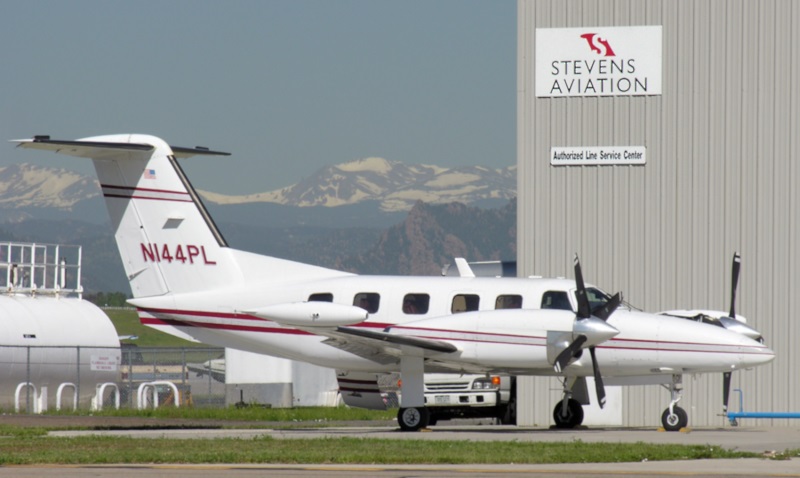
The Cheyenne III was replaced by the "Cheyenne IIIA" in 1983, the primary change being PT6A-61 engines -- with the same power ratings, but better altitude performance. The IIIA also featured more passenger headroom, a better air conditioning system, and other tweaks. Lufthansa obtained IIIAs for training with flight decks similar to those of the Airbus A310.
Total production of the Cheyenne to end of manufacture in 1984 was as follows:
Piper didn't really make an earnest effort to sell the Cheyenne, and so its production was limited. As with the Navajo, many Cheyennes remain in service, with upgrades available.
BACK_TO_TOP* In 1965, Piper began work on the "Pocono", which was more or less a scaled-up Navajo, that was to have a passenger load of 16 seats. Initial flight of the prototype was on 13 May 1968.
The general configuration of the Pocono followed that of the Navajo. The Pocono was an all-metal aircraft with a low straight wing, a conventional tail arrangement with a swept tailfin, tricycle landing gear, a cockpit door on the right forward fuselage, and a double door on the left rear fuselage. There were two cockpit seats, and sixteen passenger seats -- six rows, each row with two seats on the right, one on the left. It was to be powered by twin Lycoming TIO-720-B1A flat-six engines with 355 kW (475 HP) each.
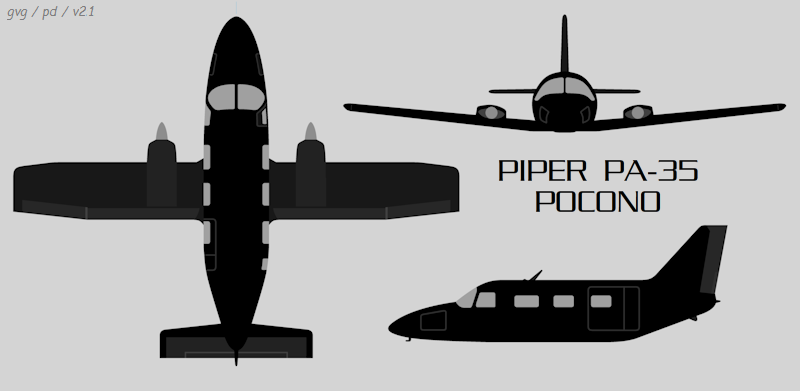
Then the program ran into trouble. The first issue was that the aircraft weight had increased significantly in the course of flight testing, and so the Pocono ended up being underpowered. Trying to find a more suitable engine was troublesome. Worse, at that time, the market for the Pocono dried up, and so the project was shelved in 1969.
___________________________________________________________________
PIPER POCONO:
___________________________________________________________________
wingspan:
15.55 meters (51 feet)
wing area:
27.2 sq_meters (293 sq_feet)
length:
12.91 meters (42 feet 4 inches)
height:
5.31 meters (17 feet 5 inches)
empty weight:
2,525 kilograms (5,570 pounds)
MTO weight:
4,425 kilograms (9,750 pounds)
max speed:
417 KPH (260 MPH / 225 KT)
service ceiling:
8,840 meters (29,000 feet)
range:
1,125 kilometers (700 MI / 610 NMI)
___________________________________________________________________
Ideas for a Pocono with four piston engines or twin turboprops went nowhere. Had the Pocono been designed with turboprop engines in mind, it might have done well, but light civil turboprops were still a novelty when it was conceived. In 1978, the fuselage and wings were sent to Poland as part of collaboration with the aviation firm WSK Mielec. Nothing came of that exercise, either. The Pocono got off on the wrong foot and never got back on the right one.
BACK_TO_TOP* The primary source for the first release of this document was the online Wikipedia, complemented by articles from the AOPA and other private aviation websites.
* Illustrations details:
* Revision history:
v1.0.0 / 01 oct 19 v1.1.0 / 01 nov 19 / General cleanup. v1.1.1 / 01 aug 21 / Review & polish. v1.1.2 / 01 jul 23 / Review & polish. v1.1.3 / 01 jul 25 / Review & polish. (*)BACK_TO_TOP
